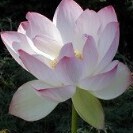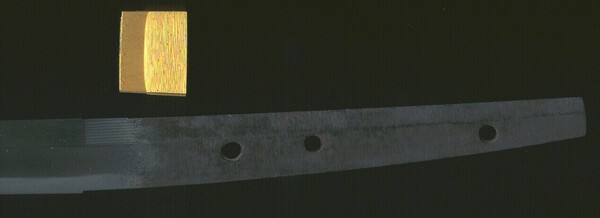-
Posts
934 -
Joined
-
Days Won
1
Content Type
Profiles
Forums
Events
Store
Downloads
Gallery
Everything posted by Franco
-
Very helpful, although, it still leaves certain questions unanswered while raising other questions, thank you for posting. Regards
-
Could we please see images of the entire sword? Thank you. Regards p.s. after viewing this video over and over it reminds me of only one other sword I've seen, a tanto.
-
Some nihonto are described as having "shirake like effects." But to go so far as calling these "effects" "shirake utsuri" is another matter. When evaluating features of a sword as part of determining quality (quality being the 2nd step in kantei according to Sato) a number of questions should come to mind. Is this feature intentional? Is this feature incidental? Is this feature accidental? Is this feature cosmetic? https://markussesko....i-2-jigane-jihada-3/ Regards
-
Cannot comment on why a Hozon level sword would receive Hozon if the boshi is missing, it shouldn't. It would appear that some like their swords with heavy make up on. There could be a number of reasons for this ranging from having something to do with; 1. quality of the sword 2. the taste of the owner 3. the ability and skill of the polisher. Or some combination of any or all of these three. Of the swords I've seen in hand I'm not seeing heavy Hadori use when the sword has been excellent as well as the polisher.
-
Hello, Thank you for this explanation. Yamanaka does not describe Yamato Shikkake swords as having utsuri. Earlier swords are described as having ji-nie and chikei. Regards
-

Identification help for sword
Franco replied to Fudoshinken's topic in General Nihonto Related Discussion
1. Where to begin ..... https://markussesko.com/kantei/ 2. The polish on this sword represents the reason why Japanese sword owners are strongly advised against using an amateur polisher and that's putting it nicely. 3. Whether or not this sword is worth saving needs to be answered. 4. You'll need to ask a trained polisher whether or not this sword can be saved. Regards -
Greetings, Utsuri, ok. Please tell us exactly what kind of utsuri we're supposed to be seeing here? I see a light colored haze below the shinogi, but I'm not ready to call that utsuri. Regards
-
"Is shown." "Knowing." "Revealed." There are matters of ethics. One being that, if for no other reason, a drawn-in boshi is not the work of the sword's original maker. Regards "Desire is the cause of suffering"
-
Wow, what a fantastic set! Thank you. Understand and agree completely. Corporations out of control. Corporations with a God Complex now with AI. Regards
-
Hello, NBTHK determines where the line(s) is/are drawn. Their game, their rules. Participation is voluntary. Regards
-
Hello, So, 5.59" + 25.3937" = 30.9837" , therefore, it is not too difficult to imagine that our subject sword here was once somewhere in the neighborhood of 32" inches long (nagasa) originally based on the approximate time period of manufacture. In other words what we are seeing was once all or at least mostly all sword. Most if not all of the original nakago was removed when shortened. I'm basing my assumption and conclusion on a 27.3" Chiyozuru Nambokucho period sword I had the pleasure of studying at length (pun intended). Below is an image of the nakago of that sword from which you can see how a nakago including the original mekugiana could be o-suriage'd and then sport just one mekugiana on a ~ 25.39" sword.
-
Hi Curran, Could we please see images of the rest of this piece and set? Thank you Regards
-
This is why having the budget to purchase an expensive Japanese sword could mean that you're only making a more expensive mistake. But then, what's the problem if you can't tell the difference, right? Regards
-
Each case is going to present its own challenges. The bo hi do not appear to have been perfectly symmetrical and lined up to each other on both sides. One side seems to run slightly deeper towards the tip than the other. Then, there has to be consideration for the distance from the tip to the ko shinogi across the top in relation to the placement and length of the yokote combined with how much boshi there is left to work with. Not an easy or simple task for the polisher especially if the hi are not perfectly aligned and now run into the kissaki. There is that, plus, we don't know what other challenges there may have been from previous polishes for the current polish/polisher. An excellent polisher will attempt to correct all previous polishing mistakes. There is only so much metal to work with. Regards
-
Then almost for certain there is at least a sliver of a boshi remaining. Yes, the boshi simply runs off is how I seem to recall it is talked about in the books. Regards
-
There may be a sliver of the boshi remaining. Don't see evidence of a cosmetic boshi drawn in. It would have to be an important sword to warrant being repolished and papered with a failed boshi. Is this sword papered? How else would you describe it? Regards
-
Regards
-

Does this katana match its proposed value by seller?
Franco replied to VRGC's topic in General Nihonto Related Discussion
What happens sometimes with nihonto is that the ha/cutting edge gets chipped. When the blade is then polished the ha gets raised up to the level of the deepest chip [in order to remove that chip]. In the areas where the hamon is shallow there is the distinct possibility that the hamon becomes interrupted, a fatal flaw. There is some indication that this may be the case here. Regards -

Possible nihonto identification
Franco replied to Muaythaimals's topic in General Nihonto Related Discussion
Please take the time to read the numerous sword care posts with links on this website. Beware that many sword kits come with uchiko. Uchiko can and will leave scratches (hike) behind. I've been purchasing and using sword oil from Bushido swords in Hawaii for decades without issue. It appears that the nakago on this sword may have been cleaned at some point adding to the challenge of correctly dating this sword. Regards -
Hello Geraint, Agree. My reply is simply trying to present things to consider especially for a beginner from a collectors perspective. I've said it before and I'll say it again. Buy what you like, but know (understand) what you're buying! Cheers
-
Ciao, 1. This is not a matter of there being something wrong here for me personally or otherwise. It is more a matter of evaluating this sword, any sword, from the perspective of meeting the criteria and standards for an upper level sword in this category. If one is going to spend good money on buying a Japanese sword, shouldn't that sword be in fact evaluated from the basis of what makes that sword a "collectible nihonto." At the very least one should buy a sword fully understanding what they are buying. 2. There are many Japanese swords for sale. Just as the quality of the sword needs to be considered in the price of the sword. The quality of the polish should weigh in. 3. This sword appears to have muneyaki. If this sword does in fact have muneyaki, the muneyaki should be carefully evaluated. Why, because the presence of muneyaki can say a lot about the quality of a sword. Muneyaki can range from being poor to excellent. The difference matters. p.s Books, read, study, study, study. Auguri
-
1. Shinshinto swords should be signed and dated with no flaws. 2. No mention of muneyaki. 3. Is this sword supposed to be in new polish? Auguri






